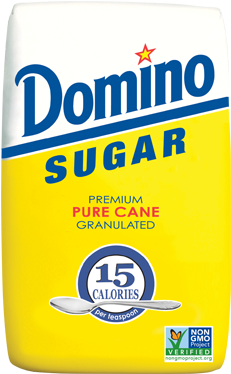Bone Char-Free Vegan Sugar Update 2021: Domino Sugar, Florida Crystals, and C&H Sugar

By Jeanne Yacoubou, MS
According to their website, ASR Group is the world’s largest refiner and marketer of cane sugar. In the United States, ASR produces sugar under these brand names: Domino Sugar, Florida Crystals, and C&H Sugar.
In April and May 2021, The Vegetarian Resource Group spoke with Michael Burchell, Senior Director, Global Corporate Quality and Daryl Sabourin, Global Director of Sustainability, about sugar processing at ASR.
We learned that they currently use three different methods for cane sugar decolorization and purification:
- Cow bone char
- Ion exchange resin using a polystyrene bed (a non-biodegradable, fossil fuel-derived plastic)
- Granular activated carbon (GAC) using coal or coconut husks
ASR Group employs all of these methods at various refineries around the country.
Burchell told us that all three processes yield sugar of comparable purity and quality. Because each type of refining requires its own type of costly, specialized equipment that has a functional life of 50+ years, changing processing methods is not frequently done.
Baltimore’s refinery converted completely away from bone char filtration in June 2015. Burchell stated that concern about using animal material, especially in light of zoonotic diseases, was one reason they made the switch.
At the Baltimore location, Domino now uses granular activated carbon (sourced from both coal and coconut husks) and ion exchange resin for processing.
The Yonkers, NY refinery eliminated bone char in the ’80s. It currently uses granulated activated carbon, as does the South Bay, FL refinery which has always been bone char-free.
By contrast, the ASR sugar refineries in Crockett, CA and Arabi, LA use bone char filtration.
In the 1990s, 90% of the cane sugar industry was using cow bone char as a filter. Burchell points out, however, that the ASR Group was already 40% bone char-free in the ’90s.
Burchell estimated that today, 65% of all ASR sugar is bone char-free.
Burchell told The VRG that consumers can tell if a particular package of Domino Sugar, Florida Crystals or C&H Sugar is completely bone char-free if the lot number appearing on the label begins with 1, 4, or 6.
The carbon footprint of cane sugar
Michael Burchell informed The Vegetarian Resource Group that methane gas was the energy source driving the sugar processing in some refineries. And where granular activated carbon was used, coal was one of the source materials.
Both methane gas from fracking and coal from mining are fossil fuels. The burning of fossil fuels is the leading cause of our climate crisis.
We wanted to know more about how the fossil fuel (also called carbon) footprints of the three industrial methods for cane sugar processing compare. This information may help educate climate-conscious consumers when they are deciding which foods and beverages to purchase.
Burchell directed us to Daryl Sabourin, ASR Group’s Global Director of Sustainability.
Sabourin was unable to tell us exactly how the fossil fuel footprints of the three sugar processing methods compare. His company has not determined what they are. Sabourin estimated that a complete assessment would cost “at least $70,000.” It isn’t required by the government and no other companies are conducting this type of analysis.
When consumers want this information and believe the extra cost through raised prices (or tax credits?) are worth it, companies may start conducting this type of analysis. A complete environmental impact assessment, including a fossil fuel footprint analysis, would provide essential information about the total environmental costs of production methods. This information would allow businesses to transition toward using only the methods which have the smallest environmental and fossil fuel footprints and be leaders in sound sustainability practices.
Sabourin estimated that for the granular actived carbon (GAC) method, coal, itself a fossil fuel, would have a higher fossil fuel footprint than coconut husks. He also estimated that since bone char manufacture and regeneration require extremely high temperatures for extended times, the bone char method would have a higher carbon footprint.
For information on other ingredients, see https://www.vrg.org/ingredients/index.php
To find out about updates, sign up for our email newsletter: https://www.vrg.org/vrgnews/index.php
To support The Vegetarian Resource Group research, donate at vrg.org/donate
Or join VRG at https://www.vrg.org/member/2013sv.php
The contents of this posting, our website, and our other publications, including Vegetarian Journal, are not intended to provide personal medical advice. Medical advice should be obtained from a qualified health professional. We often depend on product and ingredient information from company statements. It is impossible to be 100% sure about a statement, info can change, people have different views, and mistakes can be made. Please use your best judgment about whether a product is suitable for you. To be sure, do further research or confirmation on your own.
